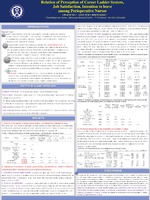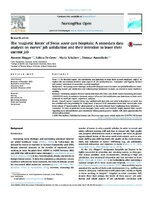| dc.description.abstract | <p>Session presented on Friday, July 25, 2014:</p>
<p><strong>Purpose: </strong>This study is the descriptive correlation study to provide the useful data for establishing strategies to improve career ladder system.</p>
<p>Methods: The subjects of the study are 154 of perioperative nurses of a general hospital in Seoul. The data were collected from April 16th to April 22th, 2013. The structured questionnaire used for this study included, the perception measurement tool of the career ladder system developed by Park Gwangok and Lee Yoonyoung (2010) the job satisfaction measurement tool for perioperative nurses developed by Yoon Gyesook and Park Seongae (2009) and the intention to leave scale developed by Lawler(1983), and modified by Park Hyunsook (2002). The data were analyzed using frequency, average, t-test, one-way ANOVA, Scheff test, Pearson's correlation Coefficient and stepwise regression analysis with the SPSS WIN 15.0 program.</p>
<p><strong>Results:</strong> 1. The average mean score for perception of career ladder system is mid-line at 2.69 point out of 4 points. The subject with higher more age (r=0.164, p<.01), higher personal growth need (r=0.164, p<.01) had higher scores for perception of career ladder system. And specialist 2 nurse has higher scores for perception of career ladder system than new nurse, general nurse and specialist 1 nurse (F=5.04, p=?.002). 2. The average mean score for is slightly high at 3.40 point out of 5 points. The subject with higher more age(r=.288, p<.001) and the longer total employment history of operation room(r=.230, p<.001) has higher scores for job satisfaction. Also, The subject with the longer total employment history of current surgery department(r=.220, p<.001) has higher scores for job satisfaction, had higher scores for stronger personal growth need has higher scores for job satisfaction (r=.318, p<0.001). The married subject has more job satisfaction than the single subject(F=4.169, p<.05). Furthermore, charge nurse has more job satisfaction than general nurse (F=5.569, p<0.05). And fixed-worker has more job satisfaction than shift worker (F=5.656, p<0.05). Specialist 2 nurse has higher job satisfaction than new nurse, general nurse and specialist 1 nurse (F=3.443,p=?.018). 3. The average mean score for intention to leave is slightly high at 3.78 point out of 5 points has. The subject with higher age(r=.194, p<.01), the longer total employment history of operation room (r=.336, p<.001), and the longer total employment history of current surgery department (r=.343, p<.001) has higher scores for intention to leave. However, the subject with stronger personal growth need has lower scores for intention to leave (r=-.308, p<.001). The nurses who have no experience of job transfer between different surgical fields in the operating room (F=15.26, p<.001) has less intention to leave. Also, type 1 that one nurse is in charge of one operating room has lower scores for intention to leave. Specialist 2 nurse has higher scores for intention to leave than the others. On the other hand, new nurse has lower scores for intention to leave than the others (F=8.513, p=?.000). 4. The subject with higher scores for perception of career ladder system has higher scores for job satisfaction (r=0.384, p<.01), and lower scores for intention to leave (r=-0.875, p<.01). Finally, the subject with higher scores for job satisfaction has lower scores for intention to leave (r=-0.251, p<.01). 5. The factors affecting the job satisfaction of the subjects are the perception of career ladder system, total employment history of operation room and personal growth need, the move-up experience to a higher level which is the subcategory of perception of career ladder system which explained 30.9 % of the variance in job satisfaction. The factors affecting the intention to leave of the subjects are, the expected effect which is also subcategory of perception of career ladder system, the number of overtime work for the last six months, personal growth need and total employment history of operation room which explained 26.1% of the variance in intention to leave.</p>
<p><strong>Conclusion:</strong> In conclusion, the perception of career ladder system of perioperative nurses is mid-line. The higher perception of career ladder system is related to the higher job satisfactions, the higher expected effect on career ladder system of the subjects is related to the lower intention to leave. Specialist 2 nurse has higher scores for perception of career ladder system than new nurse, general nurse and specialist 1 nurse's perception of career ladder system. Specialist 2 nurse also has higher scores for job satisfaction than the others, however, the intention to leave of specialist 2 nurse is the highest than the others. Therefore, it is needed to enhance the perception of career ladder system and to establish a plan how to fulfill the expected effect of career ladder system for improving a perioperative nurse's job satisfaction and reducing an intention to leave. Moreover, it is needed to establishing continuous strategies to reduce specialist 2 nurse's intention to leave.</p> | en |





